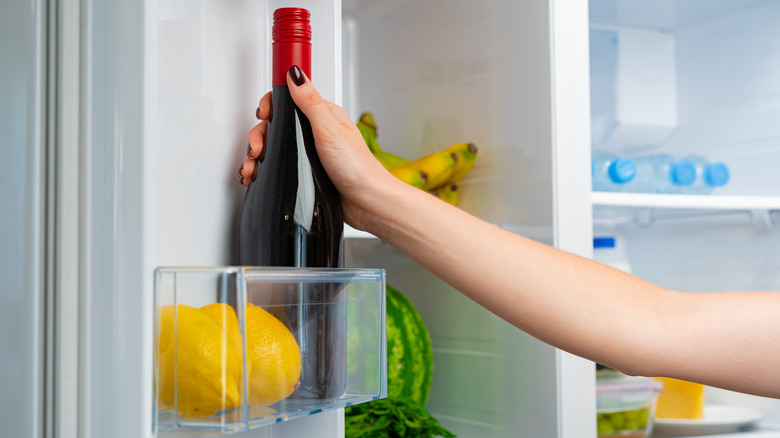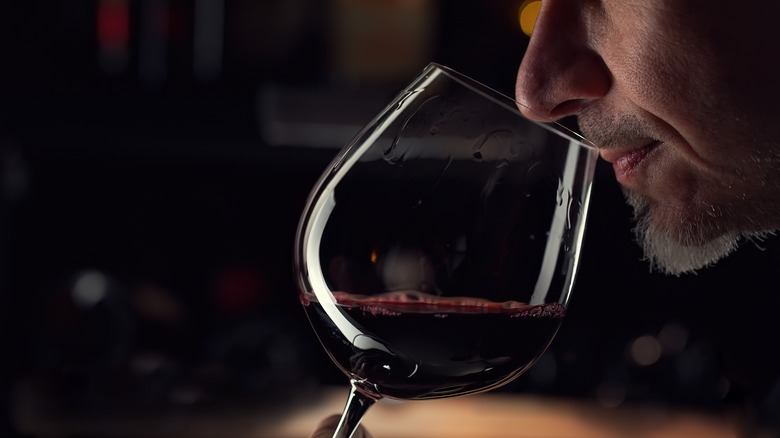How To Store Opened Red Wine To Keep It Fresher Longer
While you may believe that the bottle of red wine you didn't have a chance to finish will do just fine sitting on the counter with its cork loosely in place for a few nights, it turns out this common habit is not doing you or your leftover red any flavor favors.
Oxygen, light, and heat are enemies of red wine. Exposure to any of the three will affect its taste, aroma, and overall quality. If you want that opened bottle of your favorite red to be as fresh on the palate for as long as possible, protecting it from these elements is your best bet.
Snugly sealing the bottle will keep the oxygen out, and storing it in your cool, dark refrigerator will nix any light and heat offenders. While you may like to drink your red wine at a warmer temperature depending on its variety, storing it in the fridge between sipping sessions will help maintain its freshness longer because the colder temperature and lower humidity levels will slow down the oxidation process of the wine. Since the ideal temperature for wine is around 55 degrees Fahrenheit and refrigerators are usually around 40 degrees, they're a better option than your counter. Additionally, the dark environment will protect the wine's flavor, color, and aroma from damaging light exposure.
Several factors are at play when it comes to maintaining the freshness of an opened red, but taking the proper measures to protect the bottle from the elements may extend its life for up to five days.
How to protect opened red wine
Before putting it in the cool and dark fridge, there are several options to help seal the bottle from oxygen: stick with the cork or screw cap it came with, use a vacuum pump and the provided synthetic stopper, or invest in a gas preservation system. All methods have the same goal — to create as tight of a barrier from air as possible.
If using the bottle's original cork, inserting the more bulbous and stained end back in will prevent any foreign contaminants from coming in contact with the wine. So muscling up and maneuvering the larger side of the cork into the bottle is an extra measure you can take to maintain the wine's quality. Ensuring the cork is sufficiently inserted or using a stopper will help support the seal. Vacuum pumps are a solid option to aid in keeping the wine's integrity after opening. They work by removing the air from the bottle and creating an hermetic seal. Gas preservation systems are pricey, but they introduce gas that is heavier than oxygen into the bottle, thus protecting the wine from air exposure.
You'll want to store the bottle upright to minimize the surface area that is in contact with air inside the bottle. Another trick to lessen the liquid's exposure to air is to transfer the leftover wine to a smaller bottle or vessel (think a small sake bottle or mason jar—the more full it is, the better).
How to tell if your opened red wine has spoiled
Aside from an obvious knee-jerk reaction to spit out your sip, subtle changes to an opened red's taste can clue you into it being no longer fit for consumption. A spoiled red will be extra sour and astringent on the tongue. Any need to pucker is an indication that it has turned. The wine may also have a vinegary aroma and you may see changes to its color, with it taking on a brownish hue. Visible sediment is also common in opened red wine past its prime. Drinking opened red wine that has spoiled not only dampens your drinking experience, but it can lead to digestive disturbances or discomfort.
The type of red wine is also a factor when it comes to its post-opened shelf life. Unfortunately, the fan favorite pinot noir is extra-sensitive to air exposure. Additionally, those who opt for organic or sulfite-free wines should be wary that those varieties tend to spoil at a faster rate. Older wines are more fragile, as are those that are lighter in color, like a Zinfandel or Grenache. Earthier and richer reds, such as the popular Cabernet Sauvignon, tend to last a little bit longer once opened. This is due to their higher tannin content. Tannins are antioxidants and bind to oxygen, offering added protection from oxidation.



